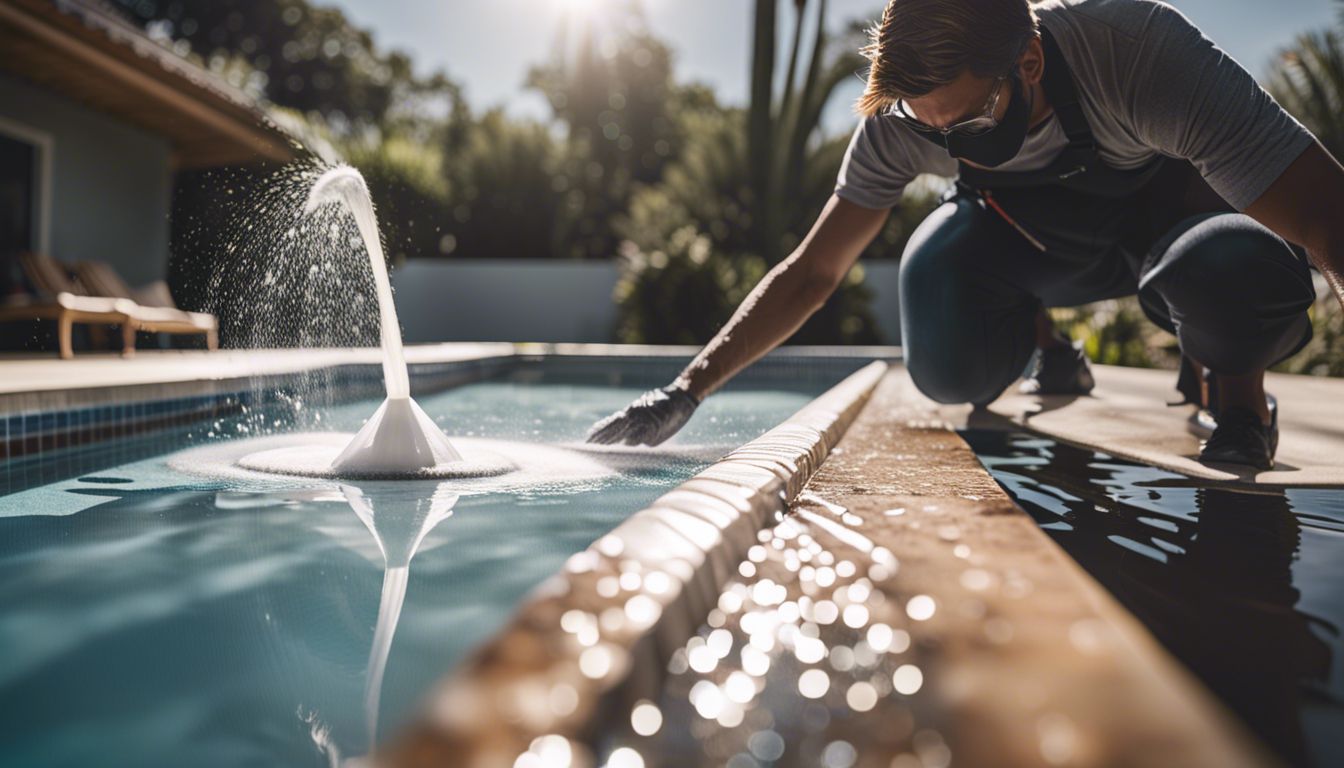How to get calcium off pool tile? Easy Ways to Clean
how to get calcium off pool tile
How to get calcium off pool tile: These white, chalky calcium deposits can take over your pool tiles and ruin the appearance of your swimming area. This blog post is here to guide you on cleaning off calcium from your pool tiles and restoring their original shine.
Dive in to reclaim your sparkling clean pool!
Key Takeaways
- Calcium scaling occurs when calcium carbonate deposits build up on the surface of pool tiles, resulting in a white or grayish crusty buildup.
- To remove calcium from pool tiles, use calcium removers, a pumice stone or nylon brush, vinegar for cleaning, or hire a professional bead blaster.
- A heavy calcium releaser effectively removes hard-to-remove calcium deposits on pool tiles without damaging the tile or affecting the pool’s pH level.
- Regular maintenance and prevention techniques, such as balancing pH levels and properly maintaining pool filters, can help prevent future calcium scaling.
Understanding Calcium Buildup on Pool Tiles
Calcium scaling occurs when calcium carbonate deposits build up on the surface of pool tiles.
What is Calcium Scaling?

Calcium scaling is a common problem with pool maintenance, as it represents the accumulation of calcium on pool tiles and floors, particularly around the waterline. This white or grayish crusty buildup results from several factors, such as high alkalinity, elevated pH levels, soaring water temperatures, and excessively high calcification in your beautiful swimming pools.
Depending upon the characteristics of your pool’s construction material – which could range from concrete to fiberglass – calcium deposits might be more prevalent, given that porous substances are typically more susceptible to mineral accumulation than their non-porous counterparts.
Causes of Calcium Scaling on Pool Tiles

Calcium scaling on pool tiles primarily results from hard water and high pH levels. Pool water evaporating, particularly on hot days, leaves behind the minerals dissolved in it, including calcium.
These minerals then form deposits or scales on your pool tiles. Additionally, heated pools with unbalanced alkalinity can also contribute to calcium buildup. Even certain chemicals in the pool may lead to this issue if not appropriately managed by a professional pool company or the pool owner.
Such accumulation of calcium scale can damage the bottom of your concrete, vinyl liner, or fiberglass pools over time while irritating guests’ eyes and skin. This makes regular maintenance critical for preventing severe calcium buildup and ensuring the optimal performance of your pool filters and the overall safety of your swimming area.
how to get calcium off pool tile: The Best Ways

To remove calcium from pool tiles, use calcium removers, a pumice stone or nylon brush, vinegar for cleaning, or hire a professional bead blaster.
Using Calcium Removers

Using calcium removers is an effective method of getting rid of hard-to-remove calcium deposits on pool tiles. Here’s a step-by-step guide:
- Start by purchasing a high-quality calcium remover, like Heavy Calcium Releaser. Remember that using the right product will not only eradicate the existing buildup but also protect pool guests from skin and eye irritation.
- Next, drain the pool water below the tile line, allowing you to access and treat the stained area easily.
- Put on personal protective equipment (gloves, goggles, etc.) to safeguard against chemical burns or irritations.
- Pour the calcium remover into a paint bucket or large container as directed by its label instructions.
- Apply the product generously with a putty knife or scrubbing brush onto the affected pool tiles.
- Allow it to sit for roughly 10 – 15 minutes; this helps dissolve severe calcium buildup without damaging your tiles.
- Use a cordless drill with a nylon bristle wheel attached to it for scrubbing away stubborn calcium crusts.
- Rinse thoroughly using fresh water to ensure no product residue that could potentially harm pool filters and equipment is left behind.
- Repeat this process until you have completely removed all signs of buildup from your pool tiles.
Utilizing a Pumice Stone or Nylon Brush

You can use a pumice stone or nylon brush to remove calcium deposits from pool tiles. These tools are effective in scrubbing away the stubborn calcium buildup without causing damage to the tiles. Here’s how to use them:
- Wet the affected area of the pool tile.
- Rub the pumice stone gently against the calcium deposits using circular motions. The abrasive texture of the stone will help remove the buildup.
- If you prefer a nylon brush, wet it before scrubbing the tiles with firm pressure.
- Continue scrubbing until all visible traces of calcium are removed.
- Rinse the area thoroughly with water to wash away any residue.
Applying Vinegar to Cleaning Pool Tiles

Vinegar is a versatile and cost-effective solution for cleaning pool tiles. It can effectively remove calcium buildup and prevent further scaling. Here’s how to use vinegar for cleaning pool tiles:
- Prepare a vinegar cleaning solution by mixing equal vinegar and water in a spray bottle.
- Spray the vinegar solution onto the affected areas of the pool tiles.
- Let the vinegar solution sit on the tiles for about 10 – 15 minutes to allow it to penetrate and dissolve the calcium deposits.
- Use a scrub brush or a pumice stone to gently remove the loosened calcium buildup.
- Rinse the tiles thoroughly with clean water to remove any residue.
- Repeat this process if necessary, especially for stubborn or severe calcium deposits.
- Vinegar is non-toxic and environmentally friendly, making it safe for humans and pets.
- It is readily available in most households, making it easily accessible for pool maintenance.
- Vinegar is affordable compared to other commercial calcium removers on the market.
Hiring a Professional Bead Blaster

Hiring a professional bead blaster is a highly effective way to remove calcium from pool tiles. This process, also known as pressure washing, involves using high-pressure water and abrasive particles to blast the stubborn calcium buildup away.
Professional pool companies have the right equipment and expertise to safely and efficiently remove the scale without causing damage to the tiles or affecting the pool’s pH level. By relying on their services, you can ensure that your pool tiles are thoroughly cleaned and restored to their original state, providing your guests with a clean and inviting swimming environment.
Tools and Chemicals for Removing Calcium

Several tools and chemicals can be used to effectively remove calcium from pool tiles. From pumice stones and nylon brushes to muriatic acid and stain removers, these options address stubborn calcium deposits.
Keep reading to learn the best methods for removing calcium buildup from pool tiles.
Pool Blok Pumice Stone

The Pool Blok Pumice Stone is a highly effective tool for removing calcium deposits from pool tiles. Made from natural pumice stone, this product is specifically designed to safely scrub away tough stains and buildup without damaging the tile surface.
It can be used on tile and concrete surfaces, making it versatile for various pool types. The porous texture of the pumice stone gently removes calcium crust and other mineral deposits, leaving your pool tiles looking clean and clear.
Used with water or a cleaning solution, the Pool Blok Pumice Stone provides an easy and efficient way to tackle stubborn calcium buildup on your pool tiles.
Dura-Gold Nylon Cup Brush
The Dura-Gold Nylon Cup Brush is essential for removing calcium from pool tiles. This brush is specifically designed to tackle tough calcium buildup without causing damage to the tile or affecting the pH level of the pool.
It works by effectively scrubbing away stubborn deposits, leaving your pool tiles looking clean and sparkling. The Dura-Gold Nylon Cup Brush is known for its heavy calcium releaser properties, making it a reliable choice for maintaining the health and appearance of your pool.
With this powerful tool, you can easily tackle those unsightly calcium deposits and keep your pool looking its best.
Using Muriatic Acid to Dissolve Deposits

One effective method to remove calcium deposits from pool tiles is using muriatic acid. Muriatic acid, hydrochloric acid, can dissolve and break down the stubborn calcium buildup on the tiles.
However, it’s essential to handle this acidic solution cautiously due to its potential for respiratory irritation and burns. To use muriatic acid, lower the water level in the pool and dilute the acid before applying it with a spray bottle or brush directly onto the affected areas.
Scrubbing with an abrasive brush helps remove microscopic bits of calcium while rinsing thoroughly with water afterward eliminates any remaining residue. It is important to note that professional assistance may be necessary if you’re unsure about handling muriatic acid or lack the required tools for safe and proper application.
Stain Removers/Stain Erasers/Calcium Removers
 Stain removers, erasers, or calcium removers are effective products designed to tackle calcium buildup on pool tiles. These solutions use mild acids and nanoformulation technology to dissolve and remove stubborn deposits without damaging the tile or equipment.
Stain removers, erasers, or calcium removers are effective products designed to tackle calcium buildup on pool tiles. These solutions use mild acids and nanoformulation technology to dissolve and remove stubborn deposits without damaging the tile or equipment.
They are easy to apply and require minimal scrubbing, making them a convenient option for pool owners. Using these specialized products, you can efficiently eliminate calcium stains and keep your pool tiles clean and well-maintained.
Natural Ways to Remove Calcium from Pool Tiles

To naturally remove calcium from pool tiles, you can use a mixture of vinegar and baking soda as a homemade cleaning solution.
Using Vinegar and Baking Soda

- Combining vinegar and baking soda can create a powerful cleaning solution for removing calcium from pool tiles.
- Mix equal parts vinegar and water in a spray bottle.
- Spray the mixture directly onto the calcium deposits on the pool tiles.
- Allow the vinegar solution to sit on the calcium for a few minutes to break it down.
- Scrub the tiles with a scrub brush or pumice stone to remove the loosened calcium.
- Rinse the tiles with clean water to remove any remaining residue.
- For stubborn calcium deposits, create a paste using baking soda and water.
- Apply the paste directly to the deposits and let it sit for several minutes.
- Scrub the tiles again to remove the calcium buildup.
- Rinse thoroughly with clean water to remove all traces of vinegar and baking soda.
[IMPORTANT FACTS]:
- Using vinegar and baking soda is a natural way to remove calcium from pool tiles.
- A heavy calcium releaser can remove calcium without damaging the tile or affecting the pool’s pH.
Tips to Prevent Calcium Scaling

– Maintain proper pool water chemistry by regularly testing and balancing pH, alkalinity, and calcium hardness levels.
– Keep the pool’s pH between 7.2 and 7.8 to prevent calcium scaling.
– Avoid using hard water for filling or topping up the pool as it contains high mineral content that can contribute to scale formation.
– Regularly brush the pool walls and tiles to prevent calcium buildup from settling.
– Use a quality pool filter and clean or backwash it regularly to ensure efficient removal of minerals from the water.
– Consider investing in a professional-grade sequestering agent or calcium inhibitor to help control mineral deposits in the pool.
Conclusion

In conclusion, removing calcium buildup from pool tiles is essential for maintaining the cleanliness and appearance of your pool. You can effectively eliminate stubborn deposits by using various methods such as calcium removers, pumice stones, or professional bead blasting.
Regular maintenance and prevention techniques will help keep your pool tiles free from unsightly calcium scaling in the future. Keep your pool sparkling clean and ready for a refreshing swim with these simple steps to remove calcium from your pool tile.
FAQs
1. What causes calcium buildup on pool tiles?
Calcium buildup on pool tiles is often a result of hard water or high mineral content in your pool, which may include substances such as calcium silicate or magnesium sulfate. As the pool water evaporates, it leaves these minerals behind, which can stick to the water line and bottom of the pool, forming crusty deposits.
2. How do I remove calcium deposits from my pool tiles?
You can employ multiple methods to remove calcium deposits from your pool tiles. Some of the most common methods include using a stiff brush or pumice stone, a vinegar solution, or a commercial calcium remover. If the buildup is significant, methods such as soda blasting might be required. Always ensure you follow instructions to avoid scratching or damaging your tiles.
3. Can I prevent future calcium buildup on my pool tiles?
Absolutely; with regular maintenance and careful management of your pool’s water chemistry, you can prevent calcium buildup on your pool tiles. Balancing your pool’s pH and alkalinity levels is crucial. Additionally, a sequestering agent or scale inhibitor can help minimize the likelihood of mineral deposits forming on your pool surfaces.
4. Is hiring a professional to remove calcium from pool tiles necessarys?
While not strictly necessary, hiring a professional to remove calcium from pool tiles can be beneficial, especially if the buildup is extensive or if the tiles are delicate, such as glass tiles. A professional has the right tools and expertise to handle the task without causing damage to the tiles. If you are comfortable with the process and have some elbow grease to spare, you could do it yourself too. However, wear protective gloves and use safe handling to avoid contact with harmful cleaning substances.
5. How can I remove calcium deposits from larger pool areas?
For larger areas of calcium buildup, you may need to use a pressure washer or specialized pool tile cleaning tools from your local pool store. Bear in mind, though, intensive cleaning methods can potentially harm soft or delicate pool surfaces. So, testing a small area first’s always a good idea.
6. How often should I clean calcium deposits from my pool tiles?
The frequency of cleaning calcium deposits off your pool tiles largely depends on your pool’s water conditions, particularly the calcium levels and pH. A high calcium level or high pH level can lead to faster buildup. Generally, a regular check and clean every few months is a good idea.











